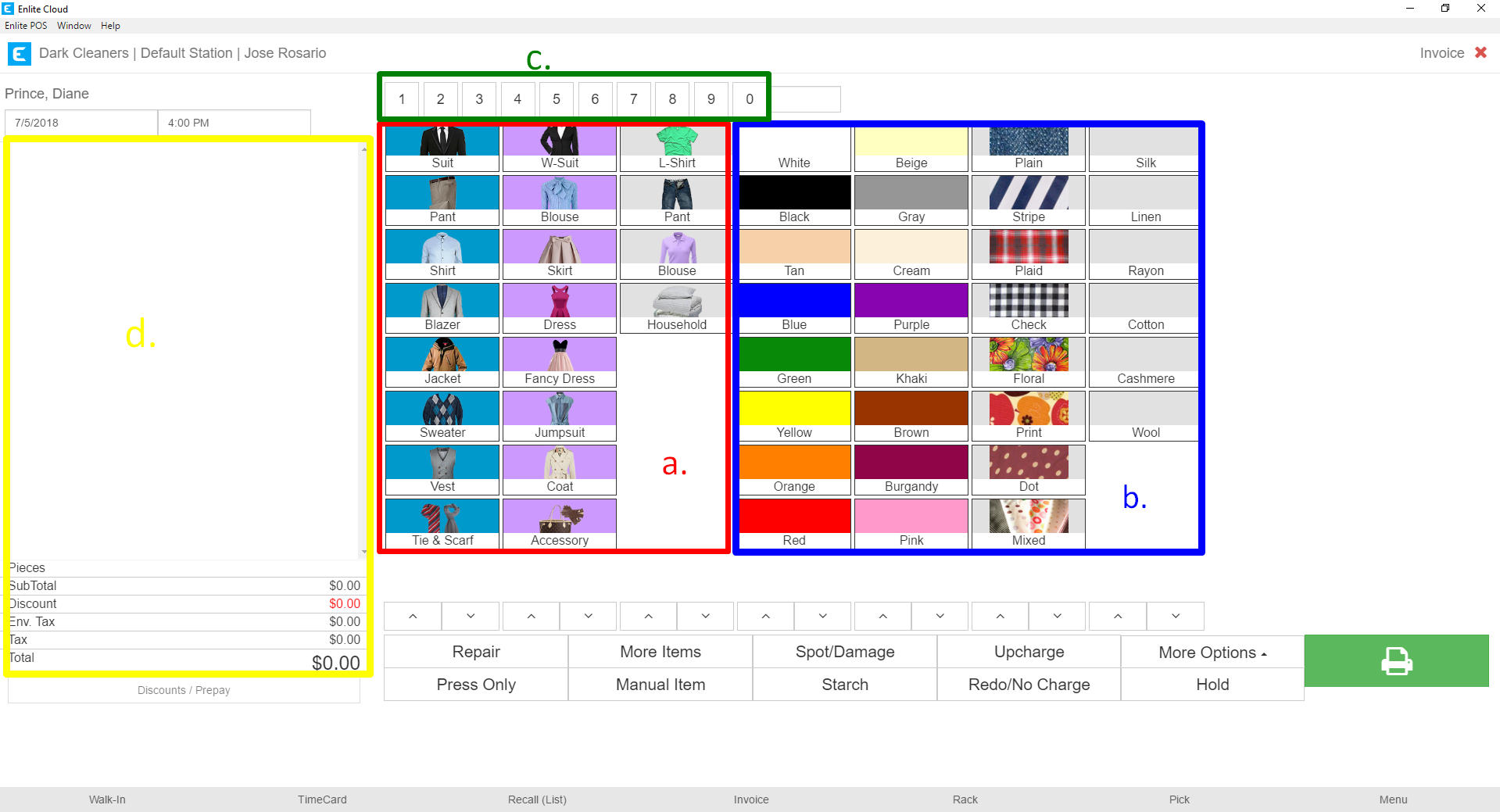- To create an invoice, search for the customer you want to create an invoice for and click the New Invoice button. If you don’t know how to search for customers or need to create a customer, please use the articles below:
a. Create a new Customer - https://help.darkpos.com/hc/docs/articles/how-to-create-a-new-customer
b. Searching for Customers - https://help.darkpos.com/hc/docs/articles/customer-walk-in-searching-for-customers

- Below are the main elements of this screen. We will get into the details of each as well as some of the other buttons and options.
a. Item Categories – These are the item categories that your store manages. Within each category, for example Suit as we’ll see on the next step, are the individual garments that reside inside the Suit category. These item category names, background color, layout and images are all customizable, so your screen may look a little different if it has already been configured with your items.
b. Item Modifiers – These are description options for your items, you can specify the color, pattern and material. The colors are also item categories, with additional shades of the colors within each color category.
c. Quantity – These are the buttons used to assign a quantity to an item. d. Item List – This area will list all the items that have been added to the invoice along with additional details that have been selected for the item. Let’s add an item.

- When I press the Suit item category, two things happen simultaneously. The first is that the a third column appears showing all the Suit options I have configured in the system. The second is that for speed, the first item from the list of Suits is added to the Item List. We can see an invoice item for an M-L 2pc Suit. We’ll review those details on the next step. If I don’t want the 2pc Suit, I just select the Suit option I need from the dynamic 3rd column that has appeared displaying all the options. So next, I will click on the Men’s 3pc Tuxedo.

- Now, the description reads Men’s 3pc Tuxedo, also, I’ve selected the Blue, Plain and Cotton buttons, you can see that description has been added to the item as well.

- The individual line items that appear in the Item List display some useful information. I’ve added a few more items to highlight the distinctions.
a. Quantity – This number indicates the quantity of items that are being entered. This field can be clicked on and edited.b. Service Tag – This indicates the service type for the garment. In this case, it is an “L” for Laundry. In the item beneath, you see a “P” for Press Only in the same position. In the last item, we see a “D” for Dry Cleaning. This field is not editable.
c. Item Name – This is the name of the selected garment. It can be clicked on and edited.
d. Starch Level – Indicates the starch level to be applied to the garment. Currently, it shows “HS” for Heavy Starch.
e. Item Modifiers – This is the list of descriptors or modifiers that have been applied to the item. It also serves as a note field. Users can click on this field and type any special instructions or requirements they may need.
f. Item Price – Indicates the price of the item. This field can be clicked on and edited.
g. Upcharge – Indicates the upcharge amount applied to the item. This field can be clicked on and edited.
h. Discount – Indicates the discount amount applied to the item. This field is not editable.

- To add items of a quantity greater than one, click on the quantity you wish to add. In this example the button “3”. If you need 2 or more digits, just click on the numbers you need. For example, for 23, I would click on the “2” then the “3”. Note that the system creates an empty line item and waits for you to select the specific item.

- Now that we have our empty line item showing quantity “3”, I select my item, in this case, pants. Now the line item indicates 3 pants.

- At the bottom of the Item List are the totals for the order as well as other important information.
a. Pieces – The sum of all the garment pieces in the order.
b. SubTotal – This is the total amount due for the order prior to discounts and taxes.
c. Discount – Sum of discounts applied to the order.
d. Env. Tax – The environmental taxes applied to this order. These are calculated at the item level and the sum is shown here.
e. Tax – The total taxes applied to the order. These are calculated at the item level ad the sum is shown here.
f. Total – The total due for the order.

- Once you have added all the items to your order, click the large green Print button at the bottom right of the screen. The documents that are printed and the number of copies for each can be configured. However, by default the system will print the following:
a. Customer Receipt – Will show all the items on the order and the customer’s ticket number. For example, a ticket number could be number 123.
b. Invoices – The invoices, or shop tickets. These are for the shop to internally label the orders. By default, the system will split tickets by service type. In the example below, we have a laundry item and a dry cleaning item. So, continuing with our ticket number 123, the system will split invoice 123-1 for the Dry Cleaning item(s) and invoice 123-2 for the Laundry item(s). The automatic splitting by service type can be disabled and invoices can be manually split as well.
c. Tags – The system will print a Wet Tag for each piece in the order. This can be disabled if your operation does not require them.
